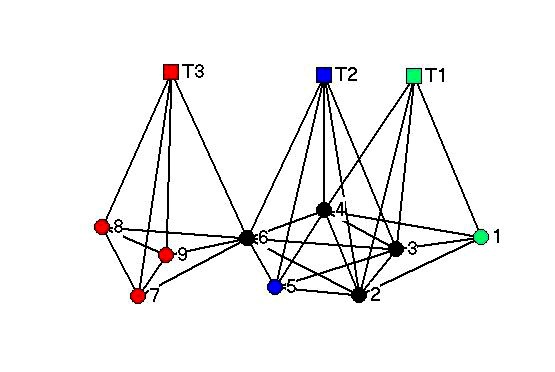 PDF(1466 KB)
PDF(1466 KB)


 PDF(1466 KB)
PDF(1466 KB)
 PDF(1466 KB)
PDF(1466 KB)
复杂网络视角下区域专利的发展演化特征——以扬州地区为例
The Development and Evolution Characteristics of Regional Patents from the Perspective of Complex Networks——Based on Yangzhou Area
[目的/意义] 从复杂网络视角研究区域专利在专利权人合作、专利申请领域的发展演化特征,为区域专利的研究方法提供一定的参考。[方法/过程]基于扬州地区1985-2020年期间申请的发明专利数据,利用复杂网络的研究方法,研究区域专利的发展演化情况,分别构建专利发展3个时期的专利权人合作关系网络和IPC技术分类合作网络,统计网络的度分布、二方组项目度分布、项目大小分布、集群系数和同类性等统计性质。[结果/结论] 通过对统计结果的分析,发现专利权人之间的合作并没有随着网络的(专利申请量)的增长而加强,不同时期下,大部分的专利仅具有独立的专利权人。从IPC技术分类合作网络来看,绝大多数专利涉及的IPC技术领域(按照IPC分类号大类)都是两项,专利涉及的技术领域间的交叉也没有随着网络的发展而加强。另外,IPC技术分类合作网络的项目大小在网络发展的不同时期都呈现出幂律分布,即按照IPC分类号大类来看,每个IPC分类号所包含的专利数表明大部分专利集中在少数的IPC技术领域。
[Purpose/significance] From the perspective of complex networks, the development and evolution characteristics of regional patents in the field of patentee cooperation and patent applications are studied, this paper provides some reference for research methods of regional patents. [Method/process] Based on invented patent information from 1985 to 2020 in Yangzhou area, this paper researched the development and evolution of regional patents by using complex network method, and got respective results of patentee cooperation networks and the IPC technology classification cooperation network of three periods, such as degree distribution of networks, node-pair degree distribution, act-size distribution, clustering coefficient and the homogeneity. [Result/conclusion] Through the analysis of statistical results, this study finds that the cooperation between patentees has not been increased with the growth of the network (patent application volume), and under different periods, there are independent patent holders of most patents. Viewed from the IPC technology classification cooperation network, the vast majority of patents cover two IPC technology fields (according to the IPC classification number category), the intersection of technology field of patents also did not strengthen with the development of the network. In addition, the project size of the IPC technology classification cooperation network shows a power law distribution at different times in the development of the network, that is, according to the IPC classification number category, the number of patents contained in each IPC classification number indicates that most patents are concentrated on a small number of IPC technology fields.

复杂网络 / 专利权人合作关系网 / IPC技术分类合作网 / 统计性质 / 幂律分布
complex networks / patentee cooperation networks / the IPC technology classification cooperation network / statistical properties / power law distribution
| [1] |
郭雷, 许晓鸣. 复杂网络[M]. 上海: 上海科技教育出版社, 2006: 2.
|
| [2] |
瞿旭晟, 赵鹏程. 现状与特征:社会网络分析在我国传播学研究中的应用[J]. 新闻爱好者, 2021(3): 67-69.
|
| [3] |
李梓涵昕, 罗萍. 社会网络分析视角下可穿戴设备产业合作创新网络特征及演化研究——基于中美专利数据[J]. 科技管理研究, 2020,40(13): 217-225.
|
| [4] |
HOLME P, LILJEROS F, EDLING C R, et al. Network bipartivity[J]. Physical review E, 2003,68(5): 56107.
|
| [5] |
LAMBIOTTE R, AUSLOOS M. N-body decomposition of bipartite author networks[J]. Physical review E, 2005,72(6): 66117.
|
| [6] |
高霞, 陈凯华. 合作创新网络结构演化特征的复杂网络分析[J]. 科研管理, 2015,36(6): 28-36.
|
| [7] |
张丰, 鲁家欣, 缪小明. 基于专利分析的新能源汽车技术创新合作网络研究[J]. 世界科技研究与发展, 2019,41(4): 358-367.
|
| [8] |
FU C, ZHANG Z, CHANG H, et al. A kind of collaboration-competition networks[J]. Physica A: statistical mechanics and its applications, 2008,387(5-6): 1411-1420.
|
| [9] |
李春林, 丁云龙. 创新型大学一流学科专利合作网络演化及其特征分析[J]. 研究与发展管理, 2014,26(3): 86-96.
|
| [10] |
刘晓燕, 李金鹏, 单晓红, 等. 动态视角下集成电路产业创新网络演化特征分析[J]. 中国科技论坛, 2019(11): 48-55.
|
| [11] |
车晓静, 吴洁, 刘鹏, 等. 高校技术研发领域和专利合作网络共同演化分析[J]. 科技管理研究, 2018,38(23): 74-80.
|
| [12] |
王珊珊, 邓守萍, COOPER S Y, 等. 华为公司专利产学研合作:特征、网络演化及其启示[J]. 科学学研究, 2018,36(4): 701-713.
|
| [13] |
封丽, 张毅华, 黄潇霏. 高校专利协同创新特征分析与比较研究——以南京地区工科类高校为例[J]. 情报探索, 2020(8): 64-68.
|
| [14] |
关鹏, 王曰芬. 国内外专利网络研究进展[J]. 数据分析与知识发现, 2020,4(1): 26-39.
|
| [15] |
胡安琪. 基于专利信息的区域战略性新兴产业发展潜力研究——以苏州智能装备制造产业为例[J]. 竞争情报, 2019,15(5): 28-36.
|
| [16] |
黄迎燕, 张伟, 周湘陵. 上市公司创新能力的专利评价[J]. 知识产权, 2008,18(4): 43-47.
|
| [17] |
肖淑芳, 石琦, 张一鸣. 上市公司创新能力指数的构建[J]. 北京理工大学学报(社会科学版), 2020,22(1): 57-69.
|
| [18] |
孟天宇. 专利密集型产业竞争力研究——以江苏省为例[J]. 技术与创新管理, 2020,41(3): 287-291.
|
| [19] |
刘杨, 赵志曼, 田睿, 等. 基于专利信息的国内主要建筑施工企业创新能力评价研究[J]. 技术与创新管理, 2019,40(2): 190-194.
|
| [20] |
王秀翠. 基于专利成果分析的高校技术创新评价研究——以南京邮电大学为例[J]. 技术与创新管理, 2019,40(5): 546-554.
|
| [21] |
林卓玲, 梁剑莹. 基础研究、科技基础设施与区域专利产出——基于省域高校面板数据的实证分析[J]. 技术与创新管理, 2019,40(5): 559-568.
|
| [22] |
刘凤朝, 马荣康, 姜楠. 基于“985高校”的产学研专利合作网络演化路径研究[J]. 中国软科学, 2011(7): 178-192.
|
| [23] |
孙丽娜, 刘姊双, 廖宝萍. 基于社会网络分析的北京校企专利合作演化分析——以北京“985高校”为例[J]. 统计与管理, 2020,35(5): 89-93.
|
| [24] |
高曼, 马英红, 张明莉. 基于专利合作申请数据分析的加权网络研究[J]. 计算机应用研究, 2018,35(1): 74-78.
|
| [25] |
杨勇, 王露涵. 我国发明专利合作网络特征与演化研究[J]. 科学学研究, 2020,38(7): 1227-1235.
|
/
| 〈 |
|
〉 |